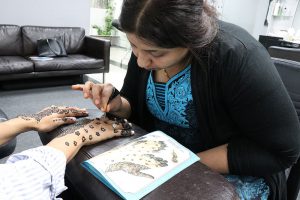By Madhurita Goswami
Medill Reports
Twenty-four-year-old Juna Syakya can draw intricate flowers or butterflies on your hands with her henna cone in less than 20 minutes. Mehndi, or henna, is a form of body art that uses a plant-based dye and Syakya brings the ancient art form to the Deeba Beauty Salon on Devon Avenue where she works.
The plant, Lawsonia inermis, grows in hot climates. Its leaves, flowers and twigs contain tannins, which are natural dyes used across the ages to create the intricate lace-like designs of henna.
“Henna is best for people who don’t want permanent tattoos. Also, it doesn’t cause infections and is way cheaper,” said Syakya’s colleague, Farzana Mirza, who is from Pakistan.

Traditionally, henna artists have been women and only women would get henna on their hands and feet. Costs range from $10-$40 depending on the area covered. Usually, henna gets washed away in less than 10 days. The dye doesn’t penetrate the skin and is safe.
However, another dye, para-phenylenediamine (PPD), is sometimes added to henna to make it darker and last longer. According to a study in Clinical and Molecular Allergy, hypersensitivity to PPD is a serious health problem worldwide for a small percentage of people.
Henna is prized in Middle Eastern, North African, and South Asian cultures. It doesn’t have a singular origin story because cultural interactions have played a big role in its migration and expression. Syakya, for example, picked up the art in Nepal about six years ago so that she could decorate women’s palms during the Teej festival. The festival is for married women to celebrate the union with their husbands.
But her friends in Chicago, many of whom are Muslims, have enriched her art. “After I moved to the U.S. and started living in this community, I have been introduced to new floral patterns and other kinds of designs.”
“In our culture, women would get henna on the day of their wedding to demonstrate love for their husbands. But now, it is associated with all kinds of celebrations,” Mirza said.
Deeba draws the most customers for henna the night before Eid. “They arrive after the moon sighting so that their hands are ready for the Eid celebrations on the next day,” Mirza said. Eid is a religious celebration that ends the Islamic observance of Ramadan.
Mirza said she likes to introduce customers to henna when they are from cultures where it isn’t a traditional art form. Laughing, she said, “They are easier to please.” Sometimes, these customers want a pattern they have seen on the internet. “We draw whatever our customers want. This can be a Mickey Mouse or a unicorn,” Mirza said.
Heeba Khan, the 35-year-old Mehndi artist at the Nikhar Beauty Salon on Devon Avenue, arrived in the U.S. with her family about three years ago. She had taken a course in Mehndi art in India’s Hyderabad and started working at the salon two years ago.
Khan has developed an easy relationship with salon manager Shaheen Khan, who is also from Hyderabad. “Flowers are very popular here. But many Americans prefer butterflies,” she said.
Her earnings help support her two children. For women Mehndi artists such as Khan, it is not only about looking after their families but also owning their space in a foreign country. “Shauk (hobby) is necessary,” she said.

